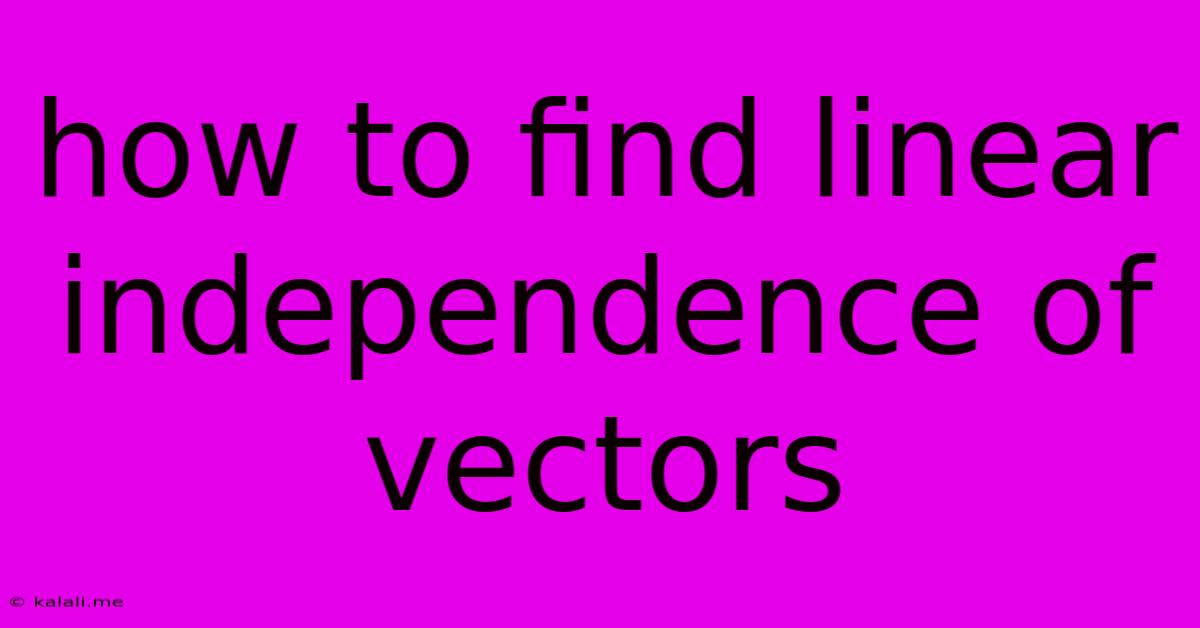How To Find Linear Independence Of Vectors
Kalali
May 31, 2025 · 3 min read

Table of Contents
How to Determine Linear Independence of Vectors: A Comprehensive Guide
Determining the linear independence of vectors is a fundamental concept in linear algebra with broad applications in various fields like computer graphics, machine learning, and physics. This article will guide you through different methods to efficiently determine whether a set of vectors is linearly independent or linearly dependent. Understanding this concept is crucial for grasping more advanced topics like basis, dimension, and rank of a matrix.
What is Linear Independence?
A set of vectors is said to be linearly independent if no vector in the set can be written as a linear combination of the others. In simpler terms, none of the vectors can be expressed as a sum of scalar multiples of the other vectors. Conversely, if one vector can be written as a linear combination of the others, the set is linearly dependent. This means there exists a non-trivial solution (a solution other than all scalars being zero) to the equation:
c₁v₁ + c₂v₂ + ... + cₙvₙ = 0
where:
- c₁, c₂, ..., cₙ are scalars (real numbers or complex numbers).
- v₁, v₂, ..., vₙ are the vectors in the set.
- 0 represents the zero vector.
Methods to Determine Linear Independence
Several methods can be employed to determine linear independence. The best approach depends on the number of vectors and their dimensions.
1. Using the Determinant (for square matrices)
This method is applicable only when the number of vectors equals their dimension (forming a square matrix). Arrange the vectors as columns (or rows) of a matrix. If the determinant of this matrix is non-zero, the vectors are linearly independent. If the determinant is zero, they are linearly dependent.
Example:
Let's consider two 2D vectors: v₁ = (1, 2) and v₂ = (3, 4). The matrix formed is:
| 1 3 |
| 2 4 |
The determinant is (14) - (32) = -2, which is non-zero. Therefore, v₁ and v₂ are linearly independent.
2. Row Reduction (Gaussian Elimination)
This is a more general method applicable to any number of vectors of any dimension. Form an augmented matrix with the vectors as columns and a column of zeros. Perform row reduction (Gaussian elimination) to obtain the row echelon form.
- Linearly Independent: If the row echelon form has a pivot in every column (excluding the last column of zeros), the vectors are linearly independent.
- Linearly Dependent: If there's at least one column without a pivot (excluding the last column), the vectors are linearly dependent.
Example:
Consider the vectors v₁ = (1, 2, 3), v₂ = (4, 5, 6), and v₃ = (7, 8, 9). The augmented matrix is:
| 1 4 7 0 |
| 2 5 8 0 |
| 3 6 9 0 |
After row reduction, you might find a row of zeros, indicating linear dependence. If there are no rows of zeros (besides the bottom row which always contains zeros), then the set of vectors are linearly independent.
3. Inspection and Observation (for simple cases)
For small sets of simple vectors, linear dependence can sometimes be determined by inspection. Look for vectors that are scalar multiples of each other or combinations of other vectors. If you can express one vector as a linear combination of others, the set is linearly dependent.
Conclusion
Determining linear independence is crucial for understanding vector spaces and solving linear systems. While the determinant method is efficient for square matrices, row reduction is a more versatile technique that works for any set of vectors. Choosing the appropriate method depends on the context and the complexity of the problem. Understanding these methods empowers you to tackle more advanced linear algebra concepts and apply them effectively in various fields.
Latest Posts
Latest Posts
-
How To Stop Facetime From Lowering Volume Mac
Jun 02, 2025
-
What Is The Change Of Getting Quads
Jun 02, 2025
-
To Virgins To Make Much Of Time
Jun 02, 2025
-
How To Acess Arcive Pages In Wordpress
Jun 02, 2025
-
Do You Naturally Float In Water Why Do People Drown
Jun 02, 2025
Related Post
Thank you for visiting our website which covers about How To Find Linear Independence Of Vectors . We hope the information provided has been useful to you. Feel free to contact us if you have any questions or need further assistance. See you next time and don't miss to bookmark.